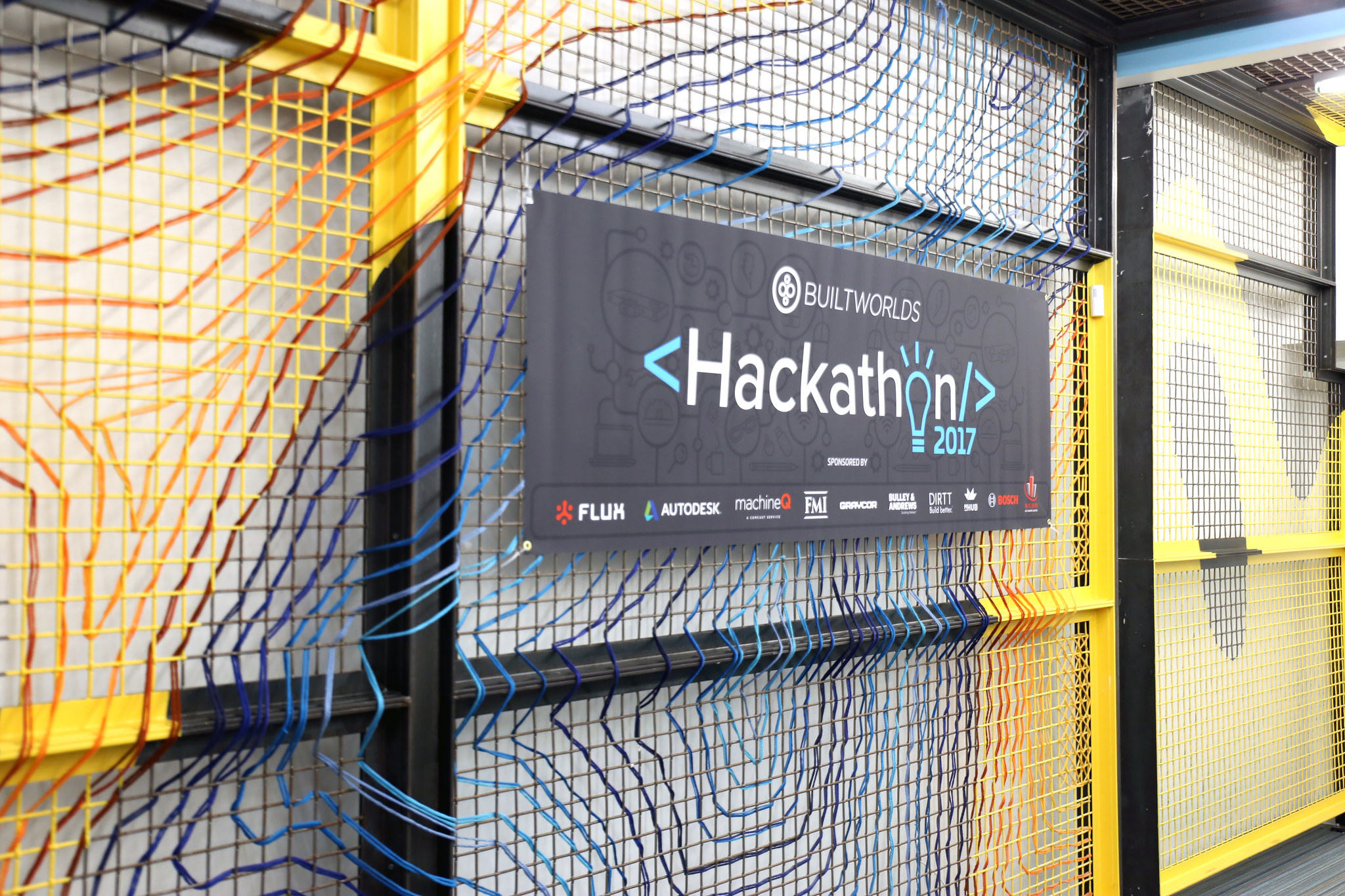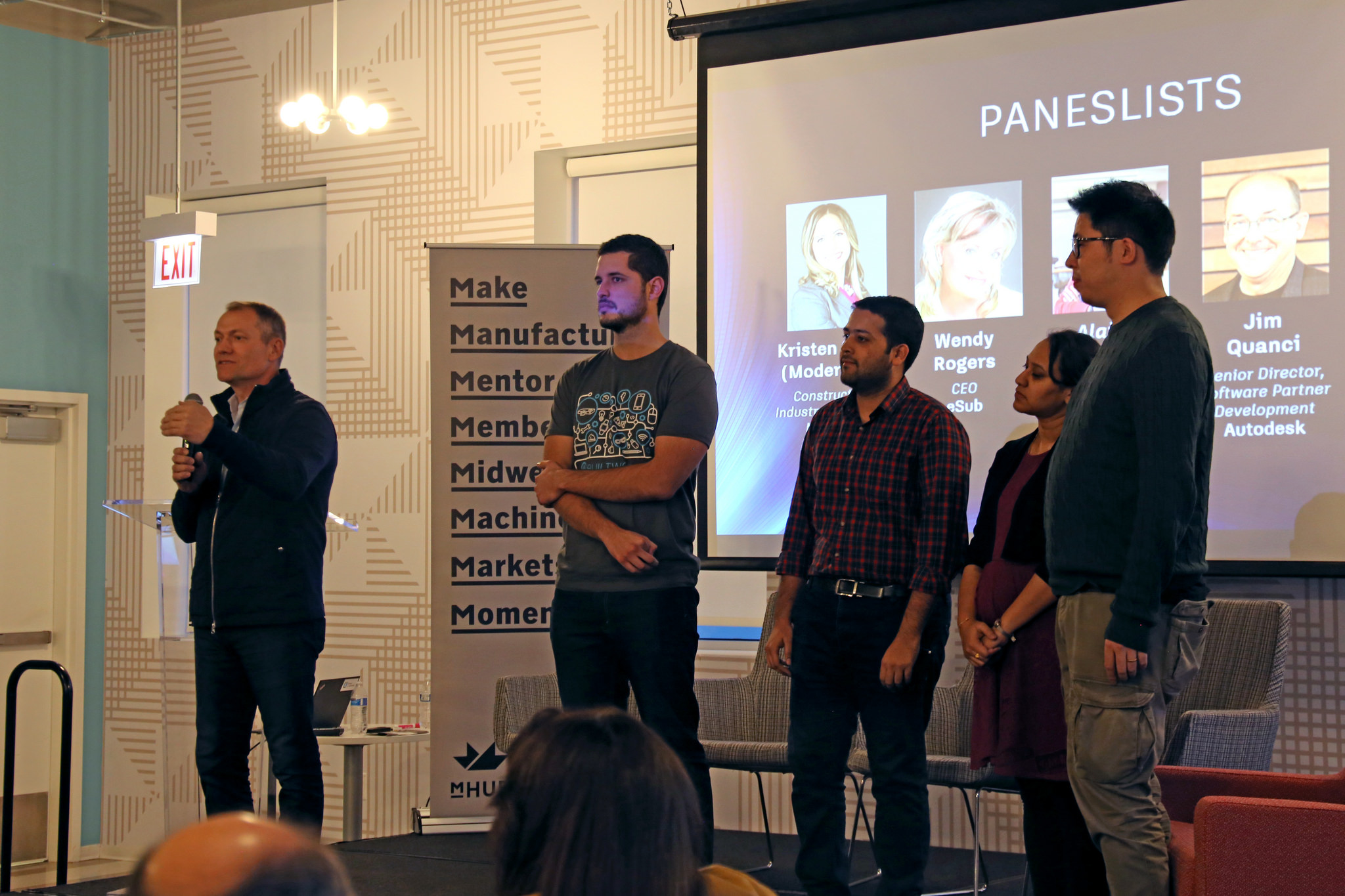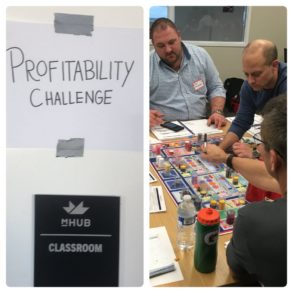
Innovation in the built world, like any other, thrives on collaboration and ingenuity.
But in this industry, you don’t often see developers/makers work and AEC professionals working closely side-by-side — that’s why BuiltWorlds continued to host, for the third year in a row, an annual Hackathon to bring the greater tech and AEC communities together.
This past weekend, more than 100 participants gathered at mHUB, a facility that opened in Chicago in 2016 to facilitate innovation in physical product development and manufacturing, to compete for cash prizes developing software, IoT technology, and business solutions.

In previous years, we partnered with the AEC Hackathon organization to put on the event — this year marks the first time that BuiltWorlds has hosted and designed its annual Hackathon independently.
“By hosting this Hackathon entirely on our own, it gave us the ability to do what we like to do — which is experiment,” says Matt Gray, BuiltWorlds co-founder. “It gave us the greatest opportunity to understand what this type of medium would be in a way that is most organic and authentic to this community.”
In the vein of a traditional hackathon, participants who chose the software track had the opportunity to spend the weekend developing a solution to a built industry problem for our cities, infrastructure, or buildings.
Alternatively, two other tracks were made available this year to further explore innovation and solutions in the built space. Participants could compete in the Makerthon Challenge to develop Internet of Things technology, or they could develop the skills to run a smarter business in the Construction Profitability Challenge.

Because BuiltWorlds doesn’t claim rights to the APIs or ideas generated throughout the weekend, many teams set to work on built solutions that they could further develop after the Hackathon. Chris Callen, founder of Grit Virtual Construction, had his team hard at work on an application to dynamically link model objects to contract documents in virtual reality.
“When I was running a construction company, I looked for software the entire time I was CEO,” Callen says. “I continued to look for something that could solve the problems I faced on my job sites and it was naught. It didn’t seem available.”
Software Track
This year, developers had three opportunities to win prizes for their software solutions. In addition to a $4,000 overall prize, Autodesk and Flux, both premier sponsors of the Hackathon, offered an additional $1,000 bonus for developers who made creative use of the Forge and Flux platforms. (We talked a little about the Forge technology here.)

A group of four — Team Batman — snagged first place overall and Flux challenge bonus with their app that leveraged Microsoft’s HoloLens technology to scan interior spaces and add objects with voice technology, with data linking back using Flux.
The second place overall team, Team Otter, won the Autodesk challenge with their solution that “reinvented” the architecture drawing review process using the Forge platform.

“Innovation comes from collaboration,” says Jim Quanci, Senior Director of Software Partner Development at Autodesk. “Innovation comes from diversity. That’s what we have here and what these teams create will often surprise you… I’m looking to be surprised.”
Diversity and collaboration, while in abundance at this year’s Hackathon, are often lost in the development process because of an industry that, according to Charles Portelli, Director of Design Technology at Flux, “is a culture of siloes.” (Flux was another premier sponsor of the 2017 Hackathon.)
“We’re in the business of bringing those siloes together and breaking down the walls between them,” Portelli says.
BuiltWorlds co-founder Matt Abeles, has recognized these divides in the past and sees events like the Hackathon as an opportunity to bridge them. “The guys who have all these construction ideas, they can’t solve them because they don’t have developer talents,” Abeles says. “The guys who are developers… they don’t know the problems going on in this industry. Bringing them together — that’s what makes this a one of a kind event.”
Makerthon Challenge
In the Makerthon Challenge, sponsor MachineQ, a Comcast company, asked participants to discover innovative uses for their LoRaWAN network, which is a long-range, low battery, low cost alternative to existing connectivity options.
“There are a lot of products, processes, and infrastructure elements of the built world that the consumer doesn’t think about on a day to day basis,” explains Marielle Lafaire, a Sales and Marketing Coordinator for MachineQ. “These elements have the potential to benefit from LoRaWAN. Smart LoRa devices allow businesses and consumers to make intelligent decisions from collected data in a way that was never before possible due to connectivity limitations.”

According to Lafaire, the data collected from these devices has the potential to save money and time and enable users to recognize and proactively remedy potentially inefficient decisions.
The winning product for the maker challenge, a prototype device dubbed “iPot,” expects to do just that.
The four-inch-wide plastic cylinder, when activated and installed in existing porta-potty units, can sense when a unit is full and in need of emptying and maintenance, with the goal of reducing O&M costs and improving end-user customer satisfaction/happiness. The iPot also features an accelerometer that notifies the owner if the unit is tipped or knocked over.
Construction Profitability Challenge


Participants that competed in the Profitability Challenge, facilitated and sponsored by FMI Consulting, optimized profit and loss statements, ran smart simulations, and honed their ability to manage the bevy of operations and processes entailed with helming a construction company.
Of the four teams that participated, three came from general contractors. But, as true Cinderella stories go, the fourth team, a group of students from Northwestern University’s Master of Project Management program, was crowned the winner of the challenge.
The inclusion of the Profitability Challenge was a new addition to the Hackathon that proved vital to the overarching mission. “Building in an element of practicality, an element of business, and having that going on simultaneously and then mixing them all together at the end with the presentations and throughout the weekend is a different way to host a Hackathon,” Nick Durham, BuiltWorlds’ B2B Marketing Manager, said.
Four teams participated in the Profitability Challenge, including three teams from general contractors and one team from Northwestern University.

When the event wrapped Sunday evening, six maker teams, nine software teams, and FMI’s Construction Profitability contestants delivered a wide range of presentations, elegantly merging the worlds of software, hardware, and business in a cohesive, all-encompassing vision for the future of the built industry.
And for the teams that didn’t walk away with prize money — there’s always the 2018 Hackathon!
Save the date for next year’s BuiltWorlds Hackathon: October 19-21, 2018
To see more photos from the event, head over to our Flickr!


Discussion
Be the first to leave a comment.
You must be a member of the BuiltWorlds community to join the discussion.